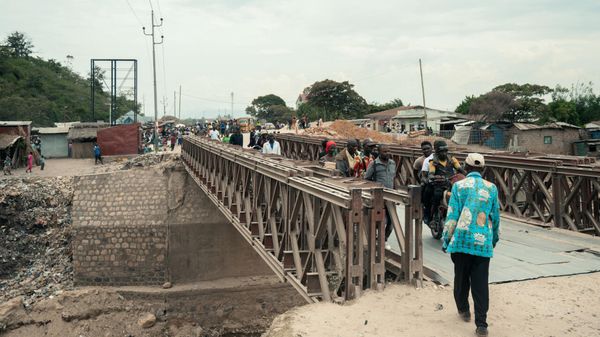
Nathan Eatts can remember the last day he caught a squid. It was 18 April, a few weeks after a brown foam and dead marine life began appearing on beaches on South Australia’s Fleurieu peninsula.
“That’s over three months now,” says the third generation squid fisher, whose business, Cape Calamari, is based on the southern Fleurieu peninsula.
“Everyone just sort of says ‘go fish for something else’, but it’s not that simple, because we’re under a quota system and 95% of what I fish for is calamari.”
Since March, Eatts has seen dead stingrays, fish and a dolphin – and that’s just at his local beach in Normanville. It is both emotionally and financially devastating. “Last time I fished, I caught four whiting,” he says. “That doesn’t pay any bills, it puts eight fillets on my table.”
The toxic algal bloom that has killed thousands of marine animals around the state has put fishers like him under pressure in areas including Kangaroo Island and the St Vincent and Spencer gulfs. Squid fishers like Eatts were among the first to feel the impact of the disaster on their business.
“We’re trying to be optimistic about squid as it’s one thing we haven’t seen wash up dead,” Eatts says.
“We’re hoping they’re in deeper water waiting for this to clear but until this clears we just have to sit back and wait, and we’re watching it get worse all the time. It’s heartbreaking.”
***
This week, under pressure from community advocates, scientists and South Australian politicians such as Greens senator Sarah Hanson-Young, the federal and state governments announced a $28m assistance package for affected communities and parliamentary inquiry into the crisis.
However the federal government has stopped short of declaring the crisis a natural disaster, which would trigger more resources, saying it did not meet relevant definitions. The South Australian premier, Peter Malinauskas, warned politicians against getting caught up in technicalities and said it should be described as a natural disaster. Senator Hanson-Young also called on the government to “declare this the emergency it is”.
For fishing businesses that have bills piling up, the pledged assistance package money is welcome help in the short term. However, it is not known when the algal bloom will clear and the industry expects there will be communities in need of more long-term support.
“There is extreme regional impact,” says Kyri Toumazos, executive officer at Seafood Industry South Australia. But some parts of the state have been hit harder than others.
Toumazos says wild catch and aquaculture businesses in Kangaroo Island have been affected since “day dot” of the disaster, as had communities south of Adelaide.
In Port Lincoln on the Spencer Gulf, where thousands of people are employed either directly or indirectly by the seafood industry, he says some aquaculture businesses were limiting their harvests due to the algal bloom. Some wild catch businesses in the area were feeling the effects too.
“The biggest concern for us is the longer the algal bloom persists, then the greater the chance of longer term impact for our fisheries,” he says.
Work to better understand the economic costs to fishing communities and the effects of the bloom on fishing stocks will take place over coming months, says Toumazos, but it could be up to a year before a detailed picture emerges. He said the state and federal governments had been receptive to the need to undertake this work.
The chair of Oysters South Australia, Peter Treloar, said the oyster industry had seen the closure of harvest zones in and around Gulf St Vincent including at Stansbury and Port Vincent and at American River on Kangaroo Island.
“The bulk of our oyster growers are located around the coastline of Eyre peninsula and they remain open for sale,” Treloar says.
“It’s worth saying that the algal bloom first appeared in Gulf St Vincent some three months ago now and the oyster growers in and around Gulf St Vincent have been closed for sales for two and a half months.”
He said these oyster growers had not been able to sell any product and have had effectively no cashflow for that entire period.
RecFish South Australia’s executive officer, Asher Dezsery, says recreational fishing tourism has also slowed. Regional areas that rely on income from short term accommodation and bait and tackle sales are suffering.
“People are cancelling their trips and not travelling around South Australia whilst this algal bloom is happening,” Dezsery says.
(September 1, 2024)
A persistent marine heatwave affects the waters off South Australia, kicked off with sea surface temperatures reaching 2.5C above average.
(March 18, 2025)
A mysterious sea foam appears at beaches on the Fleurieu Peninsula, with reports of more than 100 surfers becoming ill, and deaths of leafy sea dragons, fish and octopi.
(March 25, 2025)
Marine biologists from the University of Technology Sydney find high numbers of a tiny harmful algal species called Karenia mikimotoi in water samples collected from affected beaches.
Prof Shauna Murray – who identified the algae under the microscope and by analysing its DNA – says while still not well understood, K mikimotoi is thought to produce a reactive oxygen that caused gill cell damage in fish – which means they can not breathe.
(May 13, 2025)
By this point, more than 200 marine species have been killed by the bloom, which stretches along more than 150 kilometres worth of coastline.
(May 26, 2025)
A powerful storm and high tides washes the algae into the Coorong, staining the water like strong tea before turning it into a slurry.
(June 6, 2025)
Water testing confirms the presence of the algae in the Coorong.
(June 24, 2025)
Abnormally high tides, strong winds and large waves lashes the South Australian coastline, with multiple reports of fish deaths along the Adelaide metropolitan coastline reported in the aftermath.
(July 1, 2025)
Testing confirms the toxic algae had entered West Lakes. While the algae has been detected at the inlet, it had not yet been detected at three other testing sites.
“What this does is highlight just how important recreational fishing is to regional towns and areas such as Yorke peninsula, southern Fleurieu and the west coast.”
‘Foreseeable and even predicted’
Scientists from the Biodiversity Council warned this week that the wildlife impacts of the marine heatwave that has driven the catastrophic algal bloom were likely to be equivalent to those from the black summer bushfires and would need a similar response from governments.
They’ve called for tens of millions in additional funding for immediate environmental measures – including at least $10m to fund urgent research into the impact and possible mitigation of the bloom – and for governments to commit to seven actions to respond to the “foreseeable and even predicted” event.
That includes rapid acceleration of decarbonisation efforts because minimising ocean warming was “the most important step in preventing harmful algal blooms” along all Australian coastlines.
Darcie Carruthers, the South Australia-based nature campaigner for the Australian Conservation Foundation, spent the week travelling the coast talking to people in affected communities.
She says family-run businesses like Eatts’s squid company relied on nature being healthy and were carrying the weight of the crisis.
“In this part of Australia, healthy nature and successful business are one and the same,” she says.
“Communities and industries, including tourism, hospitality and small fishing businesses, that rely directly on a healthy marine ecosystem to survive are desperate for help and for this algal bloom to end.”
Bart Butson, a commercial fisher in Port Wakefield at the head of Gulf St Vincent, says the crisis had taken an emotional toll.
“I’m really sad to see that the Gulf is sick, it’s terrible,” he says.
“Emotionally that’s been the hardest thing for me, is to go out there and see funny coloured water and some iconic fish species dying and floating on the surface.
“I never realised how much I loved the ecosystem until it had become unwell and then it really hit me.”
While so far he has been able to get by, there is great uncertainty for his future. Many fishers he knows have been caught off-guard by the bloom, he says, and are now feeling unsure about the future of their businesses.
“They just don’t have any fish, they don’t catch fish, they don’t go fishing any more.”







